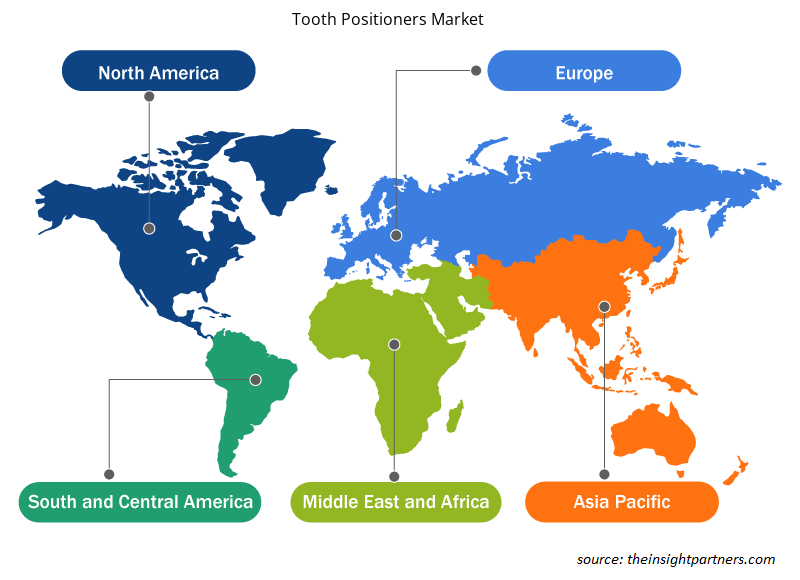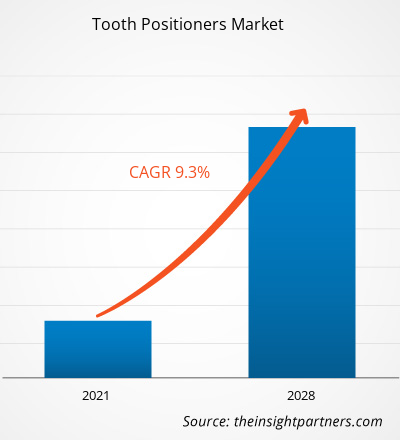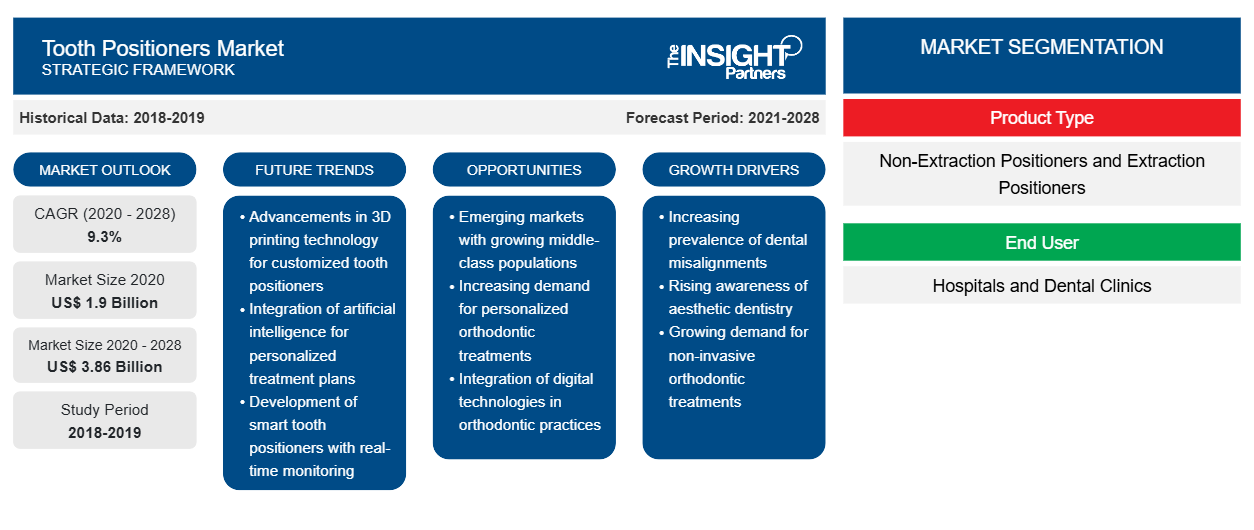Le marché des positionneurs de dents a été évalué à 1 901,91 millions USD en 2020 et devrait atteindre 3 855,65 millions USD d'ici 2028 ; il devrait croître à un TCAC de 9,3 % au cours de la période 2021-2028.
Les positionneurs dentaires sont des appareils orthodontiques bien connus, fabriqués sous forme d'un corps en forme d'arc en matériau élastique (Silastic) ; ils s'insèrent parfaitement dans la bouche du patient entre les arcades supérieure et inférieure. Ils sont utilisés pour contrôler le tassement dentaire et pour minimiser ou éliminer la récidive des dents après un traitement orthodontique.
La prévalence croissante des problèmes dentaires favorise l'adoption de systèmes de positionnement des dents. Les maladies bucco-dentaires touchent les gens au moins une fois dans leur vie. Un simple mal de dents peut provoquer une douleur insupportable, un inconfort et une défiguration. Selon le rapport de l'American Dental Association publié en 2019, 50,4 % des enfants bénéficiant de Medicaid ou CHIP et 67,1 % des enfants bénéficiant d'une assurance privée ont consulté un dentiste en 2016. La maladie parodontale, qui entraîne la perte de dents, se classe au 11e rang des maladies dentaires les plus répandues au monde. La prévalence des affections dentaires et bucco-dentaires telles que les supraclusions, les dents tordues, les sous-occlusions, les occlusions croisées, les espaces entre les dents, le surpeuplement des dents et les troubles temporo-mandibulaires (TMD) augmente dans le monde entier. Les principaux facteurs à l'origine des problèmes dentaires sont les blessures, les maladies parodontales, les accidents et autres. Selon les données de l'Association canadienne des orthodontistes, environ 4 millions de personnes au Canada et aux États-Unis suivent un traitement auprès d'un spécialiste en orthodontie. De plus, selon les données des Centres pour le contrôle et la prévention des maladies (CDC), environ 31,6 % de la population américaine souffrait de caries dentaires non traitées entre 2013 et 2016. De plus, selon un rapport d’enquête publié en 2018, 62 % des sujets ont consulté leur dentiste au moins une fois en 2016, et si 62 % d’entre eux ont consulté leur dentiste au moins une fois en 2017, 52 % ont pris leur dernier rendez-vous pour un contrôle régulier. Par conséquent, la prévalence croissante des problèmes dentaires stimule la croissance du marché des positionneurs de dents
Personnalisez ce rapport en fonction de vos besoins
Vous bénéficierez d'une personnalisation gratuite de n'importe quel rapport, y compris de certaines parties de ce rapport, d'une analyse au niveau des pays, d'un pack de données Excel, ainsi que de superbes offres et réductions pour les start-ups et les universités.
-
Obtenez les principales tendances clés du marché de ce rapport.Cet échantillon GRATUIT comprendra une analyse de données, allant des tendances du marché aux estimations et prévisions.
Informations sur le marché
La médecine dentaire esthétique est l'une des procédures esthétiques les plus courantes au monde. L'Académie américaine de dentisterie (AACD) est la principale ressource pour les patients car elle leur permet de maintenir leur bien-être, leur performance au travail et leur apparence. Selon l'American Society for Cosmetic Surgery (ASPS), la dentisterie a connu un boom récent avec une augmentation de 47 % des procédures demandées par les personnes âgées de 51 à 64 ans à 64 ans. Les coûts des cosmétiques dentaires sont moins élevés dans les pays d'Amérique du Nord. Les procédures classiques des dentistes cosmétiques et les procédures des dentistes cosmétiques de premier ordre dans les pays d'Amérique du Nord ont une différence de coût d'environ 50 à 150 USD par couronne ou facette. Les dentistes au Mexique disposent de laboratoires de haute qualité et fournissent des couronnes bon marché.AACD) is the primary resource for patients as they to maintain their welfare, work performance, and appearance. in step with the American Society for cosmetic surgery (ASPS), dentistry old a recent boom with a 47% increase in procedures demanded by people age fifty one 51–64 to sixty-four years. The costs of dental cosmetics are less in North American countries. Typical cosmetic tooth doctor procedures and prime cosmetic tooth doctor procedures in North American countries have a cost difference of ~US$ 50–150 per crown or veneer. Dentists in Mexico have high-quality labs and provide cheap crowns.
Produits : Informations technologiques
Le marché mondial des positionneurs de dents, en fonction du type de produit, est divisé en positionneurs sans extraction et positionneurs d'extraction. Le segment des positionneurs sans extraction détenait une part plus importante du marché en 2020. Cependant, le même segment devrait enregistrer un TCAC plus élevé sur le marché au cours de la période de prévision.
Utilisateur final :
En fonction de l'utilisateur final, le marché mondial des positionneurs de dents est segmenté en hôpitaux et cliniques dentaires. Le segment des hôpitaux détenait la plus grande part du marché en 2020, et le segment des cliniques dentaires devrait enregistrer le TCAC le plus élevé au cours de la période 2021-2028.
Les acteurs opérant sur le marché des positionneurs de dents adoptent des stratégies de collaboration et de partenariat pour répondre aux demandes des utilisateurs finaux grâce à l'introduction d'offres technologiquement avancées, et ces stratégies soutiennent considérablement la croissance du marché.
Aperçu régional du marché des positionneurs de dents
Les tendances régionales et les facteurs influençant le marché des positionneurs de dents tout au long de la période de prévision ont été expliqués en détail par les analystes d’Insight Partners. Cette section traite également des segments et de la géographie du marché des positionneurs de dents en Amérique du Nord, en Europe, en Asie-Pacifique, au Moyen-Orient et en Afrique, ainsi qu’en Amérique du Sud et en Amérique centrale.

- Obtenez les données régionales spécifiques au marché des positionneurs de dents
Portée du rapport sur le marché des positionneurs de dents
| Attribut de rapport | Détails |
|---|---|
| Taille du marché en 2020 | 1,9 milliard de dollars américains |
| Taille du marché d'ici 2028 | 3,86 milliards de dollars américains |
| Taux de croissance annuel composé mondial (2020-2028) | 9,3% |
| Données historiques | 2018-2019 |
| Période de prévision | 2021-2028 |
| Segments couverts |
Par type de produit
|
| Régions et pays couverts |
Amérique du Nord
|
| Leaders du marché et profils d'entreprises clés |
|
Densité des acteurs du marché des positionneurs de dents : comprendre son impact sur la dynamique commerciale
Le marché des positionneurs de dents connaît une croissance rapide, tirée par la demande croissante des utilisateurs finaux en raison de facteurs tels que l'évolution des préférences des consommateurs, les avancées technologiques et une plus grande sensibilisation aux avantages du produit. À mesure que la demande augmente, les entreprises élargissent leurs offres, innovent pour répondre aux besoins des consommateurs et capitalisent sur les tendances émergentes, ce qui alimente davantage la croissance du marché.
La densité des acteurs du marché fait référence à la répartition des entreprises ou des sociétés opérant sur un marché ou un secteur particulier. Elle indique le nombre de concurrents (acteurs du marché) présents sur un marché donné par rapport à sa taille ou à sa valeur marchande totale.
Les principales entreprises opérant sur le marché des positionneurs de dents sont :
- Orthodontie TP, Inc.
- Aligner l'orthodontie
- Laboratoire d'orthodontie Dockstader, Inc.
- DENTAURUM GmbH & Co. KG
- 3M
Avis de non-responsabilité : les sociétés répertoriées ci-dessus ne sont pas classées dans un ordre particulier.

- Obtenez un aperçu des principaux acteurs clés du marché des positionneurs de dents
Par type de produit
- Positionneurs sans extraction
- Positionneurs d'extraction
Par utilisateur final
- Hôpitaux
- Cliniques dentaires
Par géographie
-
Amérique du Nord
- NOUS
- Canada
- Mexique
-
Europe
- France
- Allemagne
- Italie
- ROYAUME-UNI
- Espagne
-
Asie-Pacifique
- Chine
- Inde
- Corée du Sud
- Japon
- Australie
-
Moyen-Orient et Afrique
- Afrique du Sud
- Arabie Saoudite
- Émirats arabes unis
-
Amérique du Sud et Amérique centrale
- Brésil
- Argentine
Profils d'entreprise
- Orthodontie TP, Inc.
- Aligner l'orthodontie
- Laboratoire d'orthodontie Dockstader, Inc.
- DENTAURUM GmbH & Co. KG
- 3M
- DENTSPLY Sirona
- Orthodontie G&H
- DynaFlex
- Laboratoires dentaires Protec
- Laboratoires dentaires Johns
- Analyse historique (2 ans), année de base, prévision (7 ans) avec TCAC
- Analyse PEST et SWOT
- Taille du marché Valeur / Volume - Mondial, Régional, Pays
- Industrie et paysage concurrentiel
- Ensemble de données Excel
Rapports récents
Témoignages
Raison d'acheter
- Prise de décision éclairée
- Compréhension de la dynamique du marché
- Analyse concurrentielle
- Connaissances clients
- Prévisions de marché
- Atténuation des risques
- Planification stratégique
- Justification des investissements
- Identification des marchés émergents
- Amélioration des stratégies marketing
- Amélioration de l'efficacité opérationnelle
- Alignement sur les tendances réglementaires























 Obtenez un échantillon gratuit pour - Marché des positionneurs de dents
Obtenez un échantillon gratuit pour - Marché des positionneurs de dents